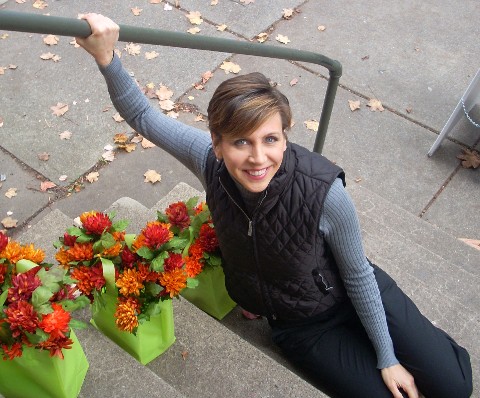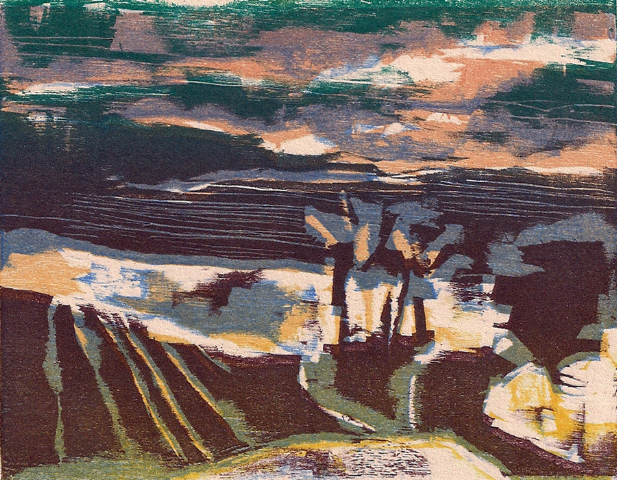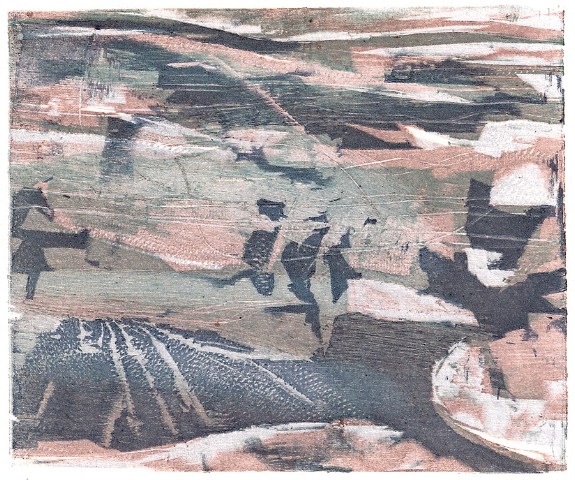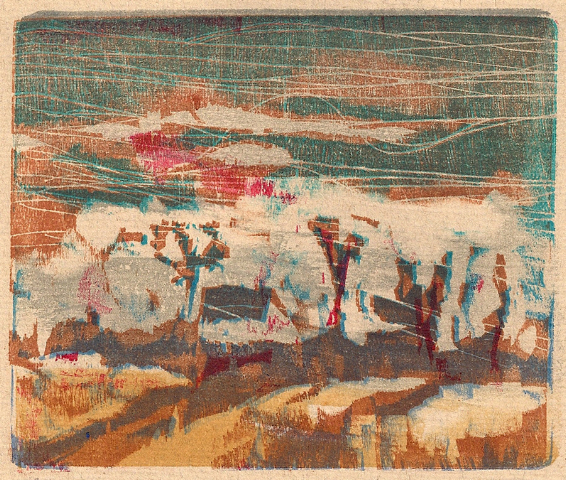Herewith a sequence of tiny beautiful woodcuts from Saratoga Springs artist/poet Mary Kathryn Jablonski, a friend for years who, yes, can remember vividly my sons as little boys, furtively writing her secret notes in the library and running up to deliver them (I am ever grateful for such memories). We have not just the woodcuts themselves but a multi-media cross-pollination event. The woodcuts are inspired by a W. B. Yeats poem (“The Two Trees”) and the poem has inspired other artists (Loreena McKennitt). You put them together and you have an experience that is aural, visual and intellectual, which is one of the lovely things about Internet publishing. And beyond that I love the artist’s own words, her heart-of-the-matter reflection on the repetitive, obsessive, persistent nature of the creative mind.
dg
————–
These very small works, the largest of which measures four by five inches, are woodblocks. The series is titled and inspired by Yeats’ poem “The Two Trees.”[1] Singer, songwriter Loreena McKennitt recorded a haunting version of this piece. Because we humans are prone to fear and creatures of habit, some would argue that we struggle with “the same problem” our entire lives. With one step forward, two steps back, we rewrite the same story. Or write the same poem. Paint the same painting. Enter the same relationship. Start the same job. In the film The Last Temptation of Christ, the Girl Angel/Satan says to Jesus, “There is only one woman in the world. One woman, with many faces.”
http://www.youtube.com/watch?v=LZeBGEwmPu4&feature=related
As an artist and poet, I process my “ravens of unresting thought” through my work, and I find this metaphor of The Two Trees particularly meaningful. Yeats begins, “Beloved gaze in thine own heart,” suggesting that relationship, indeed all emotions, all answers are rooted there. Perhaps the other is often a mirror. Expand this notion to include the possibility that only in deeply knowing ourselves can we completely engage in relationship. I am not suggesting by this that we become narcissistic. Far from it. Yeats closes with, “Gaze no more in the bitter glass.” More often relationship (to ourselves, others, and our creative work) requires an emptying, an opening. Surrender. An entire abandonment of the self.
Multi-color woodblock prints are typically made by carving, inking, and printing a separate block of wood for each color. In a “reduction print,” (those shown) only one block is used. The artist must print the entire edition in the first color, then re-carve the same block for the second color and print over those first impressions, etc. etc. for the complete number of colors the work will contain. The most challenging and freeing aspect of this technique is that the artist can never reprint the edition; can never go back to a previous version of the work; can never correct or rethink an action taken. For this reason it is also referred to as the “lost block” technique. Because printmaking is such a physical, painstaking, sequential, subtractive, and meditative process, for me it becomes a balm, much like writing. And although it may seem as if the “problem” is repeated over and over, I believe what Heraclitus said, “No man ever steps in the same river twice…”
— Mary Kathryn Jablonski
.
.
—Mary Kathryn Jablonski
———————–
A gallerist in Saratoga Springs, visual artist and poet, Mary Kathryn Jablonski is the author of the chapbook To the Husband I Have Not Yet Met (APD Press, 2008), and her poems have appeared in numerous literary journals including Salmagundi, Slipstream, Beloit Poetry Journal, and Blueline. She recently completed her first book-length collection of poems and two additional chapbook manuscripts. Her artwork has been widely exhibited throughout the Northeast and is held in private and public collections.
-
The Two Trees
by William Butler Yeats
BELOVED, gaze in thine own heart,
The holy tree is growing there;
From joy the holy branches start,
And all the trembling flowers they bear.
The changing colours of its fruit
Have dowered the stars with merry light;
The surety of its hidden root
Has planted quiet in the night;
The shaking of its leafy head
Has given the waves their melody,
And made my lips and music wed,
Murmuring a wizard song for thee.
There the Loves a circle go,
The flaming circle of our days,
Gyring, spiring to and fro
In those great ignorant leafy ways;
Remembering all that shaken hair
And how the wingèd sandals dart,
Thine eyes grow full of tender care:
Beloved, gaze in thine own heart.Gaze no more in the bitter glass
The demons, with their subtle guile,
Lift up before us when they pass,
Or only gaze a little while;
For there a fatal image grows
That the stormy night receives,
Roots half hidden under snows,
Broken boughs and blackened leaves.
For all things turn to barrenness
In the dim glass the demons hold,
The glass of outer weariness,
Made when God slept in times of old.
There, through the broken branches, go
The ravens of unresting thought;
Flying, crying, to and fro,
Cruel claw and hungry throat,
Or else they stand and sniff the wind,
And shake their ragged wings; alas!
Thy tender eyes grow all unkind:
Gaze no more in the bitter glass.“The Two Trees” is reprinted from The Rose. W.B. Yeats. 1893.↵





Heart of the matter, indeed. In word, in song, in quiet and eloquent art.
Thank you for this multi-media journey, my friends.
Mary, Very beautiful, sensitive, and quite impressive. Well done! …P.S. Megan Coleman is in the process of revising my website with new images.
Mary – I viewed your page here months ago and wrote this soon after. Running into you recently made me think of it, so here it is. I found the image of the two trees, the poem, and your woodcuts very inspiring……thanks.
(the ‘you’ in the poem is meant to be general, as in ‘oneself’)
Just the thought
of the two trees
standing on an Irish hillside
Just the thought that the road
might turn to find you also
standing there
A place to be
in the mist,
in the plaintive call of a landscape
and where a bell might sound,
a raven beckon,
where to, you ask,
where to?